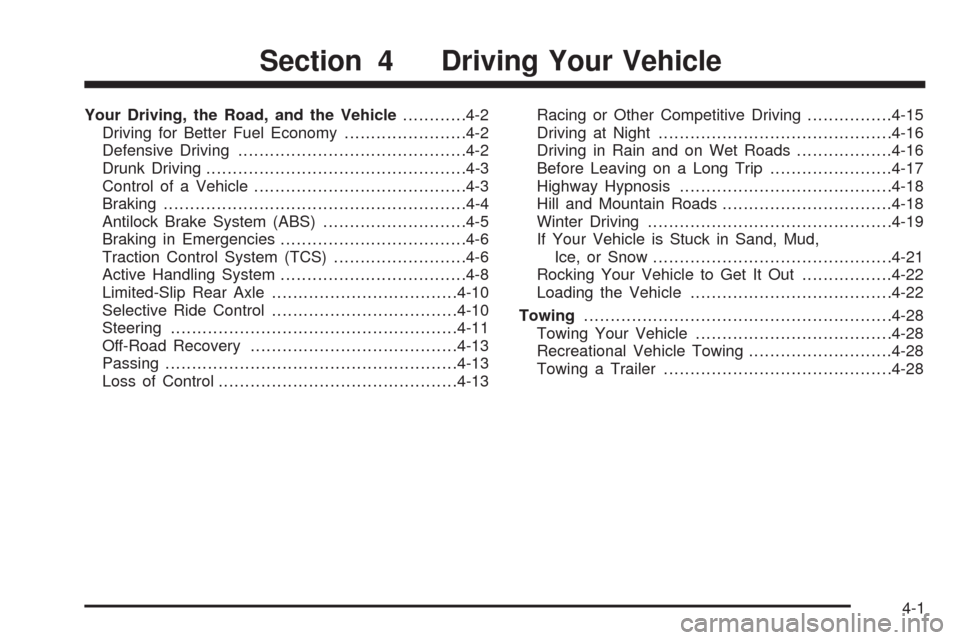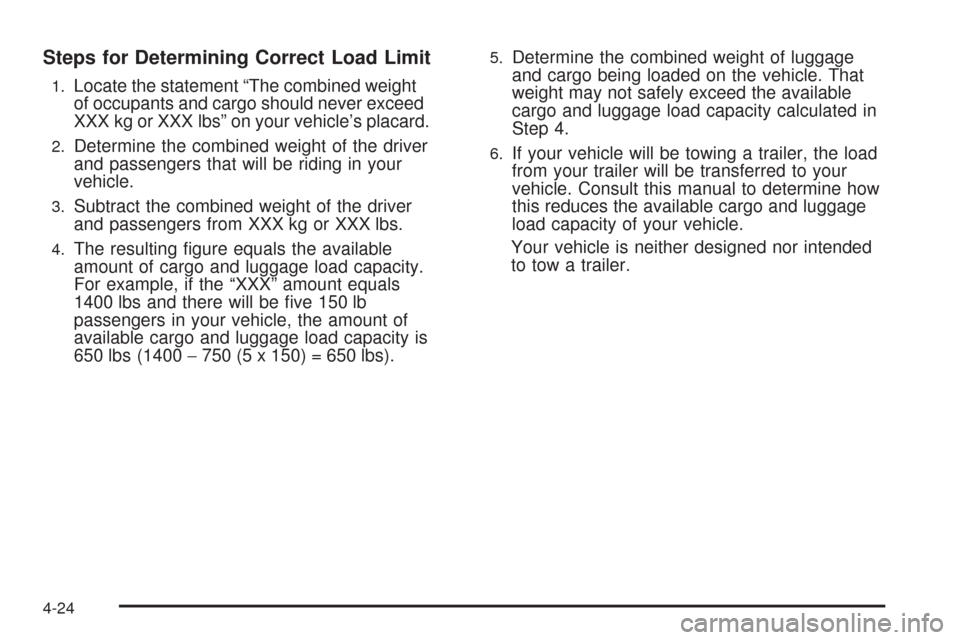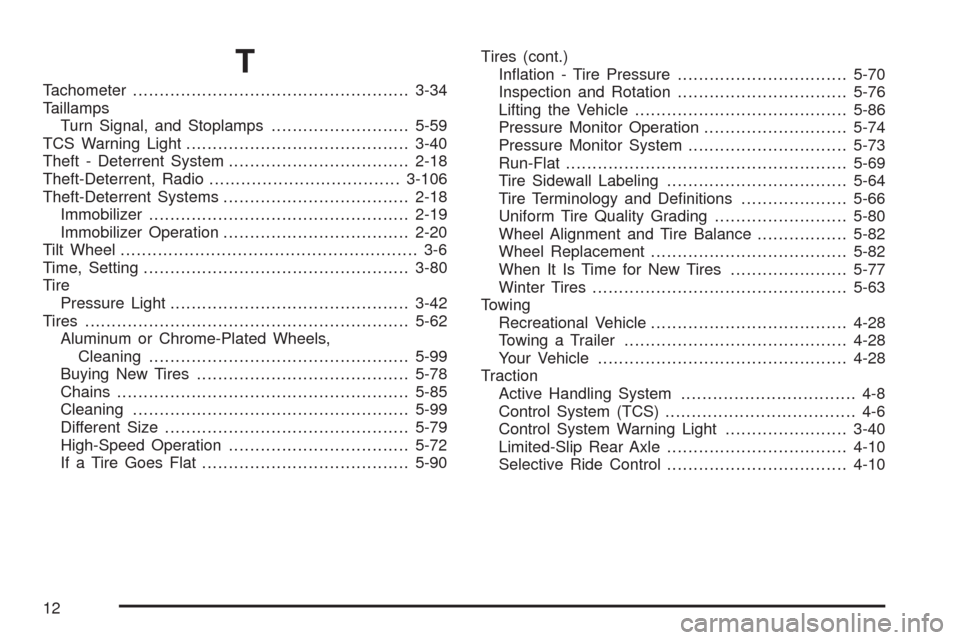Page 245 of 434

Your Driving, the Road, and the Vehicle............4-2
Driving for Better Fuel Economy.......................4-2
Defensive Driving...........................................4-2
Drunk Driving.................................................4-3
Control of a Vehicle........................................4-3
Braking.........................................................4-4
Antilock Brake System (ABS)...........................4-5
Braking in Emergencies...................................4-6
Traction Control System (TCS).........................4-6
Active Handling System...................................4-8
Limited-Slip Rear Axle...................................4-10
Selective Ride Control...................................4-10
Steering......................................................4-11
Off-Road Recovery.......................................4-13
Passing.......................................................4-13
Loss of Control.............................................4-13Racing or Other Competitive Driving................4-15
Driving at Night............................................4-16
Driving in Rain and on Wet Roads..................4-16
Before Leaving on a Long Trip.......................4-17
Highway Hypnosis........................................4-18
Hill and Mountain Roads................................4-18
Winter Driving..............................................4-19
If Your Vehicle is Stuck in Sand, Mud,
Ice, or Snow.............................................4-21
Rocking Your Vehicle to Get It Out.................4-22
Loading the Vehicle......................................4-22
Towing..........................................................4-28
Towing Your Vehicle.....................................4-28
Recreational Vehicle Towing...........................4-28
Towing a Trailer...........................................4-28
Section 4 Driving Your Vehicle
4-1
Page 268 of 434

Steps for Determining Correct Load Limit
1.Locate the statement “The combined weight
of occupants and cargo should never exceed
XXX kg or XXX lbs” on your vehicle’s placard.
2.Determine the combined weight of the driver
and passengers that will be riding in your
vehicle.
3.Subtract the combined weight of the driver
and passengers from XXX kg or XXX lbs.
4.The resulting �gure equals the available
amount of cargo and luggage load capacity.
For example, if the “XXX” amount equals
1400 lbs and there will be �ve 150 lb
passengers in your vehicle, the amount of
available cargo and luggage load capacity is
650 lbs (1400−750 (5 x 150) = 650 lbs).
5.Determine the combined weight of luggage
and cargo being loaded on the vehicle. That
weight may not safely exceed the available
cargo and luggage load capacity calculated in
Step 4.
6.If your vehicle will be towing a trailer, the load
from your trailer will be transferred to your
vehicle. Consult this manual to determine how
this reduces the available cargo and luggage
load capacity of your vehicle.
Your vehicle is neither designed nor intended
to tow a trailer.
4-24
Page 272 of 434
Towing
Towing Your Vehicle
The vehicle was neither designed nor intended to be
towed with any of its wheels on the ground.
Consult your dealer/retailer or a professional towing
service if the disabled vehicle needs to be towed.
SeeRoadside Assistance Program on page 7-7.
Notice:Dolly towing or dinghy towing the vehicle
may cause damage because of reduced ground
clearance. Always put the vehicle on a �atbed truck.
Recreational Vehicle Towing
Notice:Dolly towing or dinghy towing the vehicle
may cause damage because of reduced ground
clearance. Always put the vehicle on a �atbed truck.
The vehicle was neither designed nor intended to be
towed with any of its wheels on the ground. If the vehicle
must be towed, see “Towing Your Vehicle” earlier in
this section.
Towing a Trailer
The vehicle is neither designed nor intended to tow a
trailer.
4-28
Page 432 of 434

T
Tachometer....................................................3-34
Taillamps
Turn Signal, and Stoplamps..........................5-59
TCS Warning Light..........................................3-40
Theft - Deterrent System..................................2-18
Theft-Deterrent, Radio....................................3-106
Theft-Deterrent Systems...................................2-18
Immobilizer.................................................2-19
Immobilizer Operation...................................2-20
Tilt Wheel........................................................ 3-6
Time, Setting..................................................3-80
Tire
Pressure Light.............................................3-42
Tires.............................................................5-62
Aluminum or Chrome-Plated Wheels,
Cleaning.................................................5-99
Buying New Tires........................................5-78
Chains.......................................................5-85
Cleaning....................................................5-99
Different Size..............................................5-79
High-Speed Operation..................................5-72
If a Tire Goes Flat.......................................5-90Tires (cont.)
In�ation - Tire Pressure................................5-70
Inspection and Rotation................................5-76
Lifting the Vehicle........................................5-86
Pressure Monitor Operation...........................5-74
Pressure Monitor System..............................5-73
Run-Flat.....................................................5-69
Tire Sidewall Labeling..................................5-64
Tire Terminology and De�nitions....................5-66
Uniform Tire Quality Grading.........................5-80
Wheel Alignment and Tire Balance.................5-82
Wheel Replacement.....................................5-82
When It Is Time for New Tires......................5-77
Winter Tires................................................5-63
Towing
Recreational Vehicle
.....................................4-28
Towing a Trailer..........................................4-28
Your Vehicle...............................................4-28
Traction
Active Handling System................................. 4-8
Control System (TCS).................................... 4-6
Control System Warning Light.......................3-40
Limited-Slip Rear Axle..................................4-10
Selective Ride Control..................................4-10
12